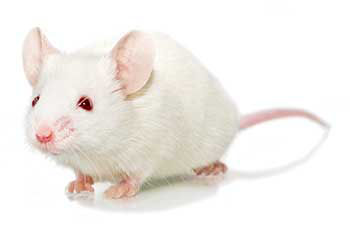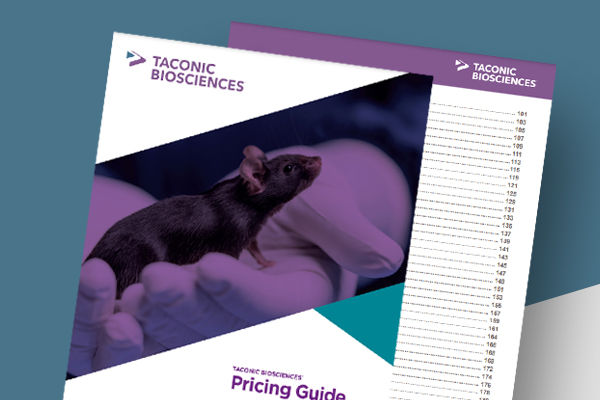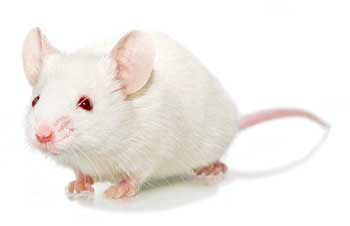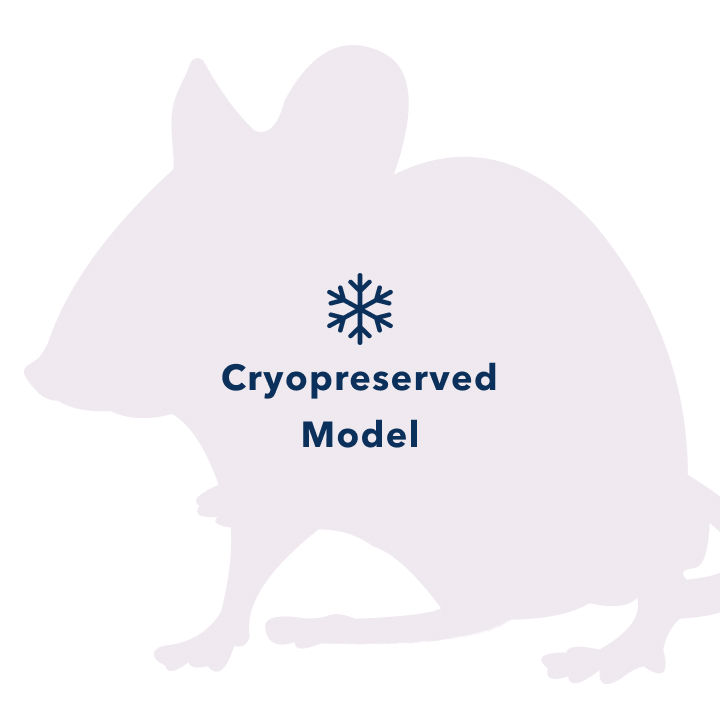| Model No. | Nomenclature | Genotype |
|---|---|---|
| 3998-F | FVB.129P2-Abcb1atm1Bor Abcb1btm1Bor Abcg2tm1Ahs N7 | ko/ko;ko/ko;ko/ko |
| 3998-M | FVB.129P2-Abcb1atm1Bor Abcb1btm1Bor Abcg2tm1Ahs N7 | ko/ko;ko/ko;ko/ko |
Mdr1a/b-Bcrp

- Description
- Related Products & Services
- Price & Licensing
- Health Report
- Overview
- Genetics
- Guides & Publications
- Applications & Therapeutic Areas
- Transit, Housing & Welfare
- Diet
Overview
Nomenclature: FVB.129P2-Abcb1atm1Bor Abcb1btm1Bor Abcg2tm1Ahs N7
- This triple targeted mutation model carries a disruption of the multi-drug resistance genes Abcb1a (encoding p-glycoprotein 3), Abcb1b (encoding p-glycoprotein 1) and Abcg2 (encoding BCRP/ABCG2)
- Useful in studies of drug transport, oral bioavailability and multi-drug resistance
- Triple homozygote mice may develop phototoxicity upon exposure to pheophorbide a, a chlorophyll metabolite, first expressed as ear lesions and can progress to mice becoming moribund. They may also display a novel type of protoporphyria characterized by elevated levels of protoporphrin IX. Both of these effects have been observed in single gene Bcrp homozygous knockouts.
- See additional information on the roles of drug transporters Bcrp, Mdr1a and Mdr1b.
Origin
The Mdr1a/b-Bcrp mouse was developed in the laboratory of Alfred Schinkel of the Netherlands Cancer Institute. The model was created through crossbreeding of the Mdr1a/b targeted mutation mouse and the Bcrp targeted mutation mouse in the Schinkel lab. The Mdr1a/b model was created through sequential targeting of the Abcb1a and Abcb1b genes in E14 ES cells. Resultant chimeras were backcrossed to FVB/N for seven generations (N7). The Bcrp model was created by targeting the Abcg2 gene in E14 embryonic stem cells derived from 129P2/OlaHsd mice and injecting the targeted cells into FVB blastocysts. Resultant chimeras were backcrossed to FVB/N for seven generations (N7). Taconic received stock of the triple targeted mutation line in April 2005. The colony is maintained by mating animals homozygous for all three mutations.
Genetics
Guides & Publications
Initial Publication:
Jonker JW, Freeman J, Bolscher E, Musters S, Alvi AJ, Titley I, Schinkel AH, Dale TC (2005). Contribution of the ABC transporters Bcrp1 and Mdr1a/1b to the side population phenotype in mammary gland and bone marrow of mice. Stem Cells, 23(8):1059-1065.
Applications & Therapeutic Areas
- ADMET
- Inflammation
- Microbiome
- Neuroscience
- Safety Assessment
- Immunology
Transit, Housing & Welfare
Need more info? Click the live chat button or Contact Us
3998 males are packed as cagemates, without recombination of animals from different cages into a single Taconic Transit Cage (TTC). We recommend that customers do NOT recombine 3998 males from different Taconic Transit Cages into the same cage at or after unpacking.
Packing Practices
Taconic standard practice is to recombine animals of different home cages and/or ages from a single model and sex during packing, except in specific cases where Taconic's animal welfare policy prohibits recombination due to aggression or other concerns. When an order is fulfilled with animals from more than one week of birth, this standard practice results in animals from a range of birth weeks packed together in a single TTC. When an order is fulfilled with animals from genotyped models, this standard practice results in animals from different home cages packed together in a single TTC.
Customers who wish to keep animals from different weeks of birth separated should place orders with the special instruction "Divide and label by age." Note that this special request can result in increased costs for additional Taconic Transit Cages, dividers and/or freight charges.
Taconic discourages other types of custom packing requests as they can have a negative impact on animal welfare. Learn more.
Diet
- Services
- Licensing
- Pricing - USD
- Pricing - EUR
- Pricing - USD Nonprofit
- Pricing - EUR Nonprofit
- Select my Health Standard
- Get Custom Pricing Guide
Mdr1a/b-Bcrp
Conditions of Use for Taconic Transgenic Models™
Taconic Transgenic Models™ (Models) are produced and distributed under rights to patents and intellectual property licensed from various institutions. Taconic sells the Models to purchasers, grants to each purchaser a right under Taconic's rights in such licensed patents and intellectual property to use the purchased Model in consideration of purchasers' acknowledgement of and agreement to the Terms and Conditions for Taconic Models, Products and Services and the following terms of use:
- Title to these Models and biological materials derived from them remains with Taconic.
- The Models will be used for research purposes only.
- The Models will not be bred or cross-bred except to obtain embryos or fetuses required for research purposes unless additional rights have been granted in writing by Taconic.
- The Models and biological materials derived from them will not be distributed to third parties or used for commercial purposes.
- Non-profit purchasers may not use this Model and/or biological materials derived from it in sponsored research or contract research studies unless it is purchased at the for-profit price.
Pricing - USD
Murine Pathogen Free (MPF) Health Standard
3998 Female
3998-F Genotype ko/ko;ko/ko;ko/ko
Pilot-sized cohorts are readily available. Large cohort requests have a minimum 8-week lead time. An estimated lead time will be provided to you within 2-3 business days.
| Age in Weeks | Quantity 1 - 999 |
|---|---|
| 3 to 10 | $ 375.00 |
3998 Male
3998-M Genotype ko/ko;ko/ko;ko/ko
Pilot-sized cohorts are readily available. Large cohort requests have a minimum 8-week lead time. An estimated lead time will be provided to you within 2-3 business days.
| Age in Weeks | Quantity 1 - 999 |
|---|---|
| 3 to 10 | $ 375.00 |
Pricing - EUR
Murine Pathogen Free (MPF) Health Standard
3998 Female
3998-F Genotype ko/ko;ko/ko;ko/ko
Pilot-sized cohorts are readily available. Large cohort requests have a minimum 8-week lead time. An estimated lead time will be provided to you within 2-3 business days.
| Age in Weeks | Quantity 1 - 999 |
|---|---|
| 3 to 10 | 341,00 € |
3998 Male
3998-M Genotype ko/ko;ko/ko;ko/ko
Pilot-sized cohorts are readily available. Large cohort requests have a minimum 8-week lead time. An estimated lead time will be provided to you within 2-3 business days.
| Age in Weeks | Quantity 1 - 999 |
|---|---|
| 3 to 10 | 341,00 € |
Pricing - USD Nonprofit
Murine Pathogen Free (MPF) Health Standard
3998 Female
3998-F Genotype ko/ko;ko/ko;ko/ko
Pilot-sized cohorts are readily available. Large cohort requests have a minimum 8-week lead time. An estimated lead time will be provided to you within 2-3 business days.
| Age in Weeks | Quantity 1 - 999 |
|---|---|
| 3 to 10 | $ 375.00 |
3998 Male
3998-M Genotype ko/ko;ko/ko;ko/ko
Pilot-sized cohorts are readily available. Large cohort requests have a minimum 8-week lead time. An estimated lead time will be provided to you within 2-3 business days.
| Age in Weeks | Quantity 1 - 999 |
|---|---|
| 3 to 10 | $ 375.00 |
Pricing - EUR Nonprofit
Murine Pathogen Free (MPF) Health Standard
3998 Female
3998-F Genotype ko/ko;ko/ko;ko/ko
Pilot-sized cohorts are readily available. Large cohort requests have a minimum 8-week lead time. An estimated lead time will be provided to you within 2-3 business days.
| Age in Weeks | Quantity 1 - 999 |
|---|---|
| 3 to 10 | 341,00 € |
3998 Male
3998-M Genotype ko/ko;ko/ko;ko/ko
Pilot-sized cohorts are readily available. Large cohort requests have a minimum 8-week lead time. An estimated lead time will be provided to you within 2-3 business days.
| Age in Weeks | Quantity 1 - 999 |
|---|---|
| 3 to 10 | 341,00 € |
Select my Health Standard
Need help choosing the right Taconic Biosciences health standard for your research?
Use the Health Standard Selector to enter your exclusion list. The tool will tell you which health standards meet your requirements.
Get custom pricing guide
Schedule A Scientific Consultation
Speak with a PhD-level Field Application Scientist who can help you select the most appropriate model and maximize your experimental success.















.jpg)

.jpg)
.jpg)
.jpg)
.jpg)





.jpg)


.jpg)
.jpg)

.jpg)


.jpg)





.jpg)

.jpg)








